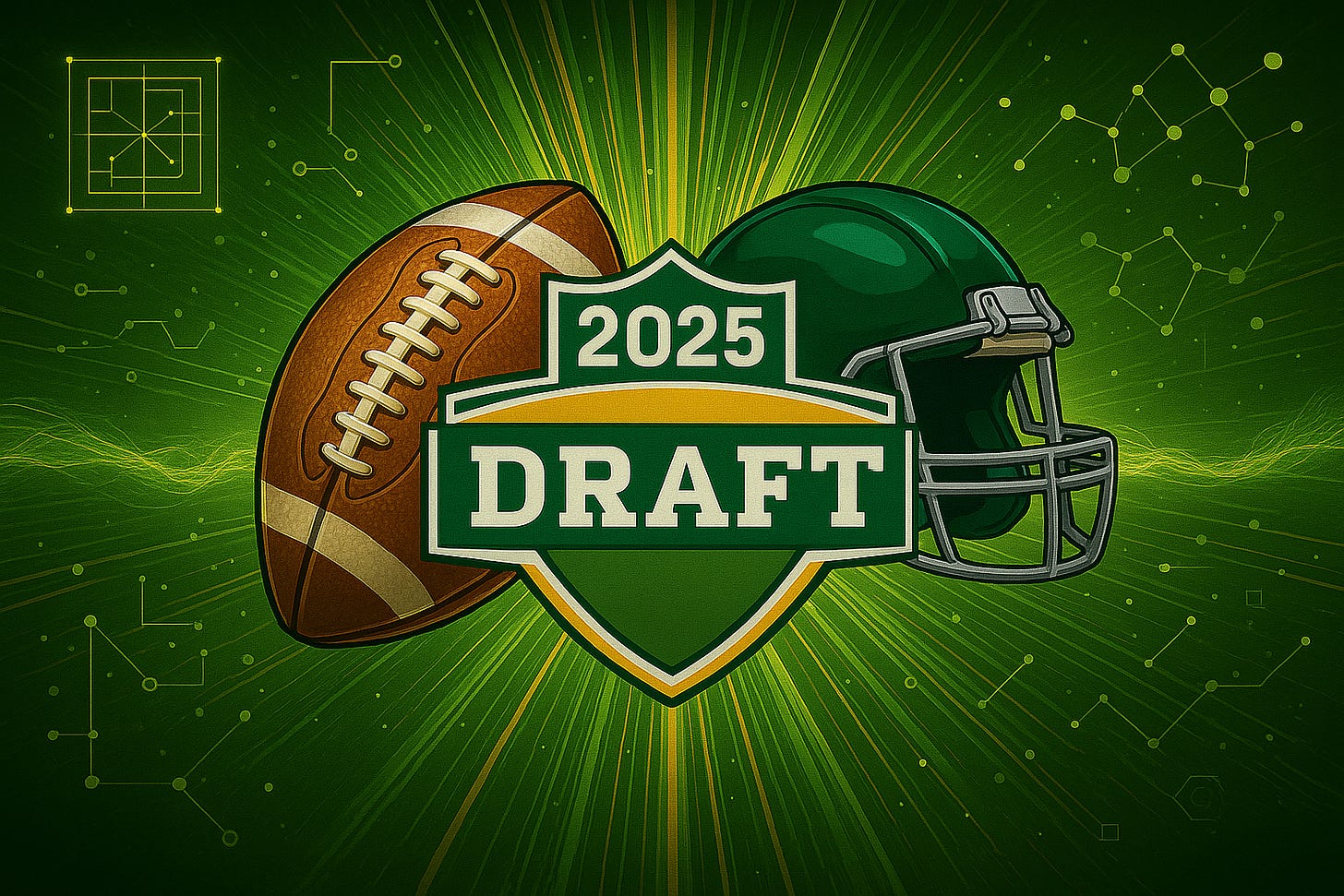2025 NFL Draft Recap: Winners and Losers
An unprecedented slide and massive trade-down for the biggest winner, while reaches and strange selections underscore the draft's disappointments
If there’s one singular event that never fails to determine the future of the National Football League, it’s the draft. Each season, around 250 young men’s lives are changed when their names are called by one of 32 teams. The draft, previously exclusively located in New York City, has recently changed locations on a yearly basis. This year, I was fortunate enough to attend the draft in Green Bay. Typically, after a draft, writers draft (get it) articles highlighting which teams they believe had the most and least successful draft classes, and this article will mirror that structure. While it’s premature to rank draft classes before draftees have played a single down of professional football, these rankings are an amazing way to get to know the classes, and see which teams most likely put themselves in a position to succeed in the following season and beyond. So, without further ado, here are my top five and bottom five draft classes from the 2025 NFL draft.
Biggest Winners:
#1 - Cleveland Browns
Entering the draft, it felt obvious as to what the Browns would do. With the second overall pick. After all, it made perfect sense to draft Wide Receiver and Defensive Back phenom Travis Hunter, right? In the second round, Cleveland could easily get a quarterback, potentially even Shedeur Sanders if he somehow managed to fall beyond the first round. Beyond that, they could still solidify other positions of need with their later selections. And yet, the Browns… did none of those things correctly. Their draft class is one that perfectly encapsulates just how unpredictable the NFL draft is, and while the textbook draft seemed like it would be successful, the absolutely insane draft that we saw in reality took it to a whole new level. Cleveland began the first night of the draft by trading away the second overall selection that would become Travis Hunter, in exchange for the Jacksonville Jaguars’ first round pick in both this year's and next year’s drafts, as well as the 35th overall selection this year. They then selected a fantastic defender in DT Mason Graham as their first round selection. The Browns then had two early selections on the second day of the draft, in underrated linebacker Carson Schwesinger and Ohio State running back Quinshon Judkins, both filling huge positions of need. They selected a solid tight end in Harold Fantin before concluding day two by selecting a quarterback above Shedeur Sanders, taking Oregon’s Dillon Gabriel. The Browns rounded out their draft with two day two selections. They further bolstered their running back room with Dylan Sampson out of Tennessee. And then, against all odds, they selected projected first round quarterback Sheduer Sanders in the fifth round.
While Cleveland’s draft was bizarre, it’s hard to not be thoroughly impressed. The Browns solidified multiple offensive positions of need, gave themselves not one, but two shots at a future franchise QB, acquired a new defensive cornerstone, and set themselves up in a great position for next year’s draft, with two first round selections. It is for those reasons that I believe that the Browns are the biggest winners of this year’s draft.
#2 - New York Giants
Well, we did just discuss the team that (would’ve) picked second overall, so why not discuss the team that picked third? The Giants had an incredible draft class, selecting the other elite talent at the top of the board - edge rusher Abdul Carter from Penn State - at third overall, declining to reach on a quarterback. Then, the G-Men made a bold move, trading up from the second round back into the first to select high-upside, Ole Miss quarterback Jaxson Dart, hopefully securing a future star at the most important position. The Giants then followed up in the third and fourth rounds by selecting two absolute steals, Toledo DT Darius Alexander, and Arizona State RB Cam Skattebo. They secured a high upside project at the game’s most important position, two bargain selections, and one of the two best overall players in the draft. New York made some fantastic moves that should (hopefully) aid their franchise for a long time.
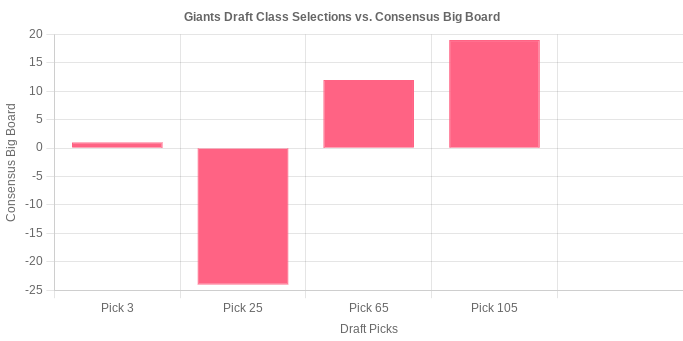
#3 - Baltimore Ravens
The Ravens are a perfect example of a team making the most of the draft despite only possessing late round selections. For those who aren’t familiar, teams with better regular season records are given later picks in order to keep a competitive balance in the league. However, teams occasionally make late selections and still draft players at bargain prices to fill each of their needs, which is exactly what the Ravens did this year.
The Ravens began night one by selecting Malaki Starks, a versatile defensive back, to help aid Kyle Hamilton in a Ravens secondary that was disappointing last season. In the second round, the Ravens managed to land Marshall edge rusher Mike Green, who many expected would go decently high in the first round. Baltimore then made another great selection in the third round, taking LSU offensive lineman Emery Jones Jr. to help shore up an inconsistent offensive line. The Ravens then made several great day three selections to help add depth around the roster, including kicker Tyler Loop to compete with Justin Tucker for the starting job next season. Overall, it’s hard not to be impressed with what Baltimore managed to accomplish this draft.
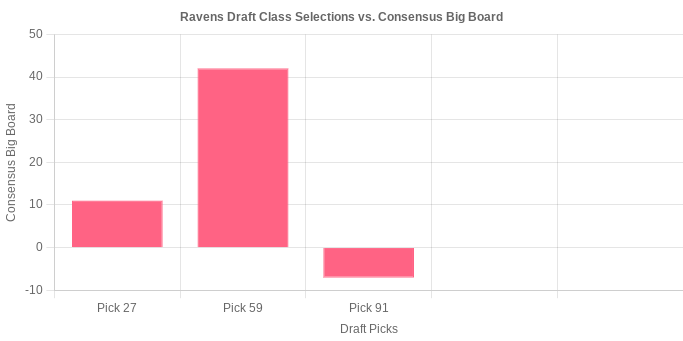
#4 - Dallas Cowboys
I hate to admit it, but the more I look at the Cowboys draft, the more I like it. The Cowboys began with a pick that I’m actually not a huge fan of, slightly reaching on Alabama offensive lineman Tyler Booker to replace retired offensive guard Zack Martin. The Cowboys then took an interesting philosophy in the next two rounds. Instead of reaching on a wide receiver, a position of need, the Cowboys instead took two bargain players that I believe made their draft. In the second round, the Cowboys snagged Boston College defensive end Donovan Ezeiruaku, a player who many (including myself) were surprised made it out of the first round. With their third selection, the Cowboys got an absolute bargain with Cornerback Shavon Revel Jr. from East Carolina, a player who easily would have gone in the first round and been considered one of the best cornerbacks in the draft if not for a torn ACL towards the end of last season. One more selection that I like from the Cowboys was their fifth round pick, taking Texas running back Jaydon Blue to help fill the still-evident void in the running back room. While there are arguments to be made that Dallas failed to acquire players at their biggest positions of need (most notably wide receiver), the reason I love the Cowboys draft is that they managed to draft three players who easily could have gone in the first round. Dallas added three future stars to their lineup, and I wouldn’t be surprised if all three became franchise cornerstones for the team
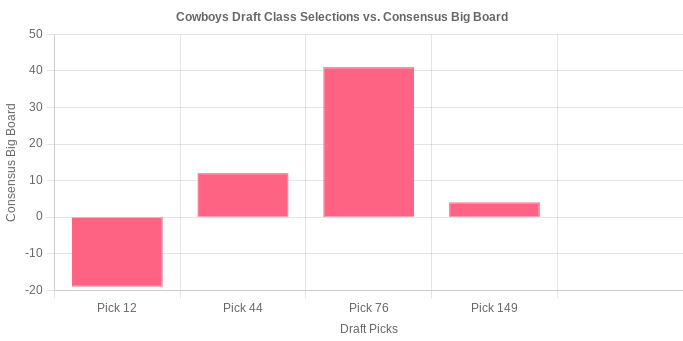
#5 - Seattle Seahawks
Honorable mentions to the Bills and Cardinals, who both also could have been in this spot. Overall, I love what Seattle did this draft. Coming into the draft, Seattle had two selections in both the second and third rounds due to prior trades of WR D.K. Metcalf and QB Geno Smith, and it was clear Seattle was ready to make some moves. Seattle began by selecting offensive lineman Grey Zabel in round one, a player who provided aid at their biggest position of need. Seattle then traded one of their third round picks to skyrocket up in the second round and select South Carolina safety Nick Emmanwori, a player who I believe should have been selected in the first round of the draft. The Seahawks then made another great second round selection in tight end Elijah Arroyo, a player who was dominant at Miami and who fell as far as he did only because of the high quality tight end class he found himself in. Then, the Seahawks selected hyper-athletic quarterback Jalen Milroe in the third round, an incredible prospect to sit behind Sam Darnold. Seattle then finished out their draft on day three with some solid depth selections. While they didn’t make any massive splashes, each of their selections provide some great help to the team, and I would not be surprised if this class pumps out multiple pro bowlers.
Biggest Losers:
#1 - Cincinnati Bengals
While I do have this class ranked last, it’s worth noting that this draft featured no teams who consistently made mind-numbingly bad decisions, just a few picks that I’m not a huge fan of. The Cincinnati Bengals came into this draft with one goal in mind: help the defense. The Bengals defense was… not very good last year, and contracts to several key offensive players meant that they couldn’t afford to add much high-end talent through free agency. I expected a draft filled almost exclusively with defensive players, and Cincinnati instead opted to draft split right down the middle, with three offensive and three defensive picks. With their first pick, the Bengals opted to take Texas A&M edge rusher Shemar Stewart, arguably the most polarizing player in the draft. While Stewart has the best athleticism of any player available, he put up relatively poor college production, with only 4.5 sacks in each of his three college seasons. While he has incredible upside and could be a fantastic player, there’s a very decent chance Stewart is unable to fully achieve his potential. The second round selection from the Bengals was linebacker Demetrius Knight, a pick which I honestly consider to be a pretty decent reach on the Bengals part. The Bengals then made a few more selections that felt a little off, and had what I would consider to be a relatively poor class, hinging very heavily on the production of the draft’s most boom-or-bust player.
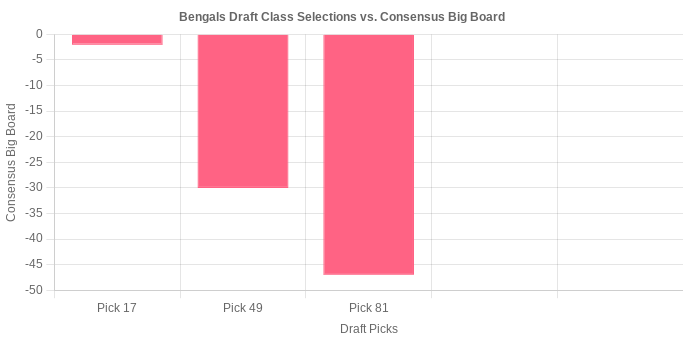
#2 - Atlanta Falcons
I’ll give the Falcons two things. First, the first selection they made, defensive end/linebacker Jalon Walker, was an incredible value/great pick. And second, the Falcons definitely added some incredible players at their biggest weakness from last season, the pass rush. However, Atlanta made one of my least favorite moves in the draft too. After the great Jalon Walker selection, the Falcons thought it was necessary to trade back into the first round, using both their second round selection as well as their first round selection from next year’s draft, in order to select a second defensive end, James Pearce Jr. from Tennessee. While Pearce is undoubtedly talented, he also features a multitude of character concerns that took him off of several teams’ draft boards, and he plays the same position as the first player the Falcons selected. In a very deep edge class, there was very little need for the Falcons to put their 2026 draft at a huge disadvantage in exchange for selecting Pearce. Otherwise, I do like the selection of Notre Dame safety Xavier Watts in the third round, but I believe that this Falcons draft hinges too much on instant production of their two first round selections, and put them at a large disadvantage for next year’s draft.
#3 - Minnesota Vikings
I’m sure Henry will love putting this on his website.1 Last season, the Vikings traded up a whopping three times early on in the draft in order to secure both quarterback J.J. McCarthy and edge rusher Dallas Turner. While those trades both still have a chance to pan out for Minnesota, they did highly limit the team’s draft capital this season. The Vikings made only five draft selections, the lowest in the league, and only one of them was in the first two rounds. That selection was Donovan Jackson, an Ohio State offensive lineman who many considered a second round talent. The Vikings aren’t ranked even lower for me is for two reasons: First, it’s hard to dislike this draft too much for decisions made during last year’s draft, which shouldn’t really impact the grading. And second, both the third round selection of receiver Tai Felton and the fifth round selection of Tyrion Ingram-Dawkins made for some very solid value picks, and both could become decent contributors for the Vikings. While the team was disadvantaged for this draft and their total number of selections proves that, a couple of decent value picks save them from being my lowest rated draft class.
#4 - Detroit Lions
I simply didn’t like most of the selections made by Detroit during this draft. The Lions began by making a pick I consider a reach, selecting Ohio State defensive tackle Tyleik Williams. I do like the fit of Williams in Detroit, but it was definitely puzzling to see this be Detroit’s first round selection. Easily, my favorite pick from Detroit this draft was their second round selection of Georgia guard Tate Ratledge, a player who I think will do a great job reinforcing their offensive line. However, I questioned each of Detroit’s last four selections. Most notably among those picks was the third round selection of WR Isaac TeSlaa, a player who will likely struggle to see the field in Detroit and was considered a massive reach by most analysts. Overall, Detroit’s draft class was filled with puzzling decisions and picks I would consider to be big reaches.
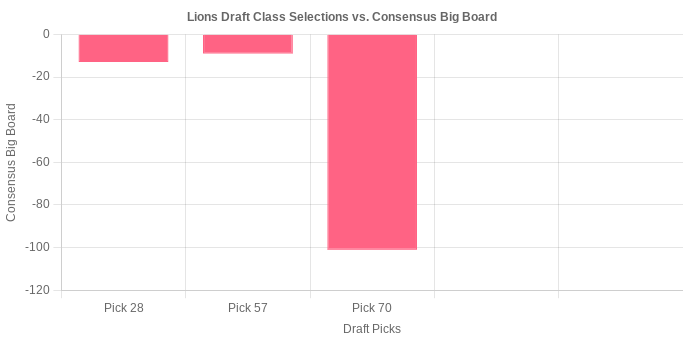
#5 - Miami Dolphins
Honorable mentions to the Buccaneers - who escaped this slot because of the overall talent of their selections despite some very questionable team fits - and the Chicago Bears, who also made some strange positional investments throughout the majority of the draft. The reason that the Dolphins are ranked so low isn’t necessarily due to the talent of their top two selections. 13th overall pick Kenneth Grant is undoubtedly a great player, albeit a little bit of a reach at his draft spot. I love guard Jonah Savaiinaea from Arizona, and I think he will be a tremendous player. I also think that the selection of Ollie Gordon II in the sixth round was a steal, and will give them tremendous depth at the running back selection. However, The Dolphins just lacked draft capital to make a lot of high quality selections - as they traded both their third and fourth round picks in order to move up in the second round to select Savaiinaea - and the draft class overall reflects this lack of depth from the mid rounds. While the Dolphins landed some good players, I believe that the overall upside of this class is highly limited due to that second round trade up.
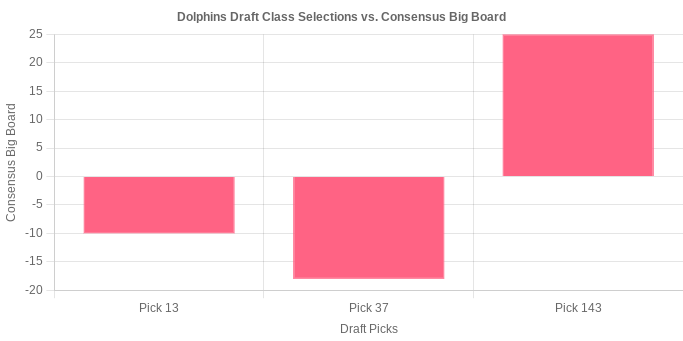
While I’ve gone through and ranked each of these draft classes, it’s important to note that the draft just shows a fragment of the careers of each of these players. Once we see each of these draftees play in actual NFL games, it will become easier to identify who actually had the best and worst draft classes. However, considering the current stance of the draft, these are the teams who I believe made the best and worst selections overall.
Henry here - I indeed did not enjoy this part.
This guest article was reviewed and edited for grammatical and accuracy purposes, and for clarity. No opinions were altered.





